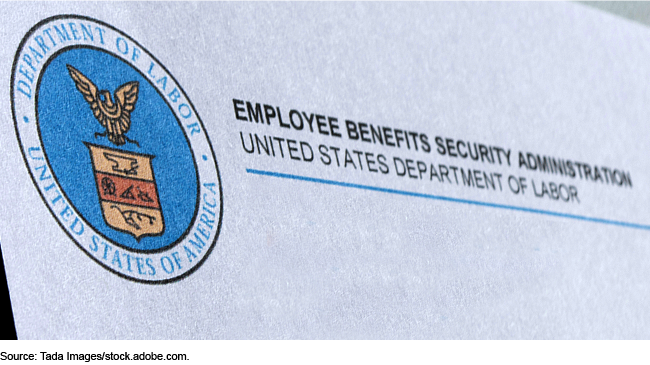Employee Benefits Security Administration: Systematic Process Needed to Better Manage Priorities and Increased Responsibilities
Fast Facts
The Employee Benefits Security Administration helps ensure that employer-sponsored retirement and group health plans comply with applicable federal requirements, and that benefits are there for participants as promised.
While EBSA's responsibilities have increased over the last decade, its budget has generally remained flat. EBSA officials said the agency has several strategies to manage this, like focusing resources on high-impact investigations or dedicating supplemental funds toward maintaining staff. But it doesn't have a clear and systematic process to reallocate resources.
We recommended EBSA document the process to help manage resources.

Highlights
What GAO Found
The Employee Benefits Security Administration (EBSA) resources have generally remained unchanged while oversight responsibilities have increased over the last decade. EBSA's Congressional Budget Justifications show that, over the 2013 to 2021 period, EBSA's annual appropriations have generally remained flat in nominal terms, but declined in inflation-adjusted terms. EBSA also experienced a decline in staffing levels (full-time equivalents) over the same period. Since 2020, EBSA's overall budget has increased due to supplemental appropriations. For example, EBSA's discretionary appropriation was $181 million each year from fiscal years 2015 through 2021. However, EBSA received supplemental appropriations in 2020 and later--$1 million in 2020, or $182 million total appropriations, and $19.2 million in 2021 or $200.2 million total appropriations. Officials said that because the agency's base budget has been flat while expenses, including those from rising wages, have continued to increase, the agency increasingly relies on supplemental funds. EBSA officials said that the agency has received many new responsibilities through legislation such as the Patient Protection and Affordable Care Act, the Families First Coronavirus Response Act, the Coronavirus Aid, Relief, and Economic Security Act, and the No Surprises Act of 2021.
EBSA has employed strategies to manage resources, but does not have a systematic process to address reallocations. EBSA's strategic planning documents describe a number of strategies for managing resources that align with the three themes of our framework for managing declining resources. For example, agencies should consider both short- and long-term cost-cutting and cost-avoidance strategies—EBSA has prioritized activities with high monetary recoveries as a key long-term strategy to manage its resources.
Additionally, agencies should use data analytics to guide decision-making—EBSA used data on case performance and recoveries to establish quantitative goals to increase its monetary recoveries in fiscal year 2022. Although EBSA officials said they use several strategies to manage declining resources, the agency does not have a clear or systematic decision-making process for doing so. Officials cited attempts to estimate resources for certain priorities, but these resource estimates were not acknowledged or included in planning documentation.
Federal internal control standards state that agencies should use quality information and that significant changes to the agencies’ oversight, programs, and other resources should be communicated across the agency through established reporting lines to appropriate personnel. Without a systematic and well-documented decision-making process, EBSA officials may not have adequate information for making informed decisions about how to manage resource reallocations to meet its increased responsibilities.
Why GAO Did This Study
EBSA is the agency within the Department of Labor (DOL) primarily responsible for ensuring that, as of fiscal year 2022, about 747,000 employer-sponsored retirement plans and about 2.5 million group health plans comply with requirements in Title I of the Employee Retirement Income Security Act of 1974. EBSA's effective oversight of plan management is critical to protect against mismanagement and fraud and to ensure that promised benefits will be available for the nearly 152 million workers, retirees, and their families covered by these plans. We previously reported on EBSA's strategies for prioritizing investigative staff as well as its enforcement process, but the current state of EBSA's resource planning is unknown.
This report examines (1) how EBSA's resources and its oversight responsibilities have changed over time; and (2) the extent to which EBSA has developed a plan to strategically manage resources.
GAO examined EBSA's Congressional Budget Justifications from fiscal year 2013 through fiscal year 2024 and interviewed EBSA officials. GAO reviewed relevant EBSA documents, prior GAO reports, federal studies, and federal laws and regulations regarding any new requirements for EBSA's oversight and enforcement of retirement and healthcare plans. GAO compared selected EBSA planning documentation against GAO's framework for managing declining resources. GAO also interviewed five stakeholder groups selected to obtain a range of retirement and health perspectives.
Recommendations
GAO recommends that the Secretary of Labor direct EBSA to develop and document a systematic decision-making process for oversight responsibilities and allocating staff in a changing budget environment, which could be incorporated within current planning documents.
In its written response, EBS indicated it would better document its resource planning process, in accordance with our recommendation.
Recommendations for Executive Action
| Agency Affected | Recommendation | Status |
|---|---|---|
| Department of Labor | The Secretary of Labor should direct EBSA to develop and document a systematic decision-making process for oversight responsibilities and allocating staff in a changing budget environment, which could be incorporated within current planning documents. (Recommendation 1) |
EBSA agreed with our assessment of the agency's mission and its budgetary challenges, but disagreed with our conclusion that the agency had not adequately documented its decision-making process. However, EBSA also said it would take further steps to enhance its formal documentation of that process, in accordance with this recommendation. The agency also agreed it could better document the resource planning process to increase transparency-and that it will review its current documentation processes and implement appropriate changes. In addition, EBSA specifically noted that it plans to document the operation, maintenance, and decision-making process associated with employee training in a way that is consistent with our recommendation. We will monitor the agency's progress on these efforts. As of January 2025, we await an update on the agency's progress.
|
